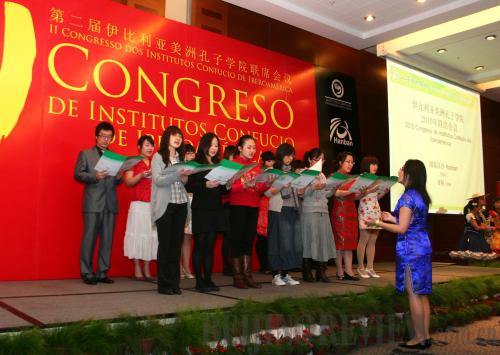|
 |
|
LOVE OF LANGUAGE: Students from the local Confucius Institute in Chile's coastal city of Vina Del Mar demonstrate their Chinese language abilities during the opening ceremony of the Second Congress of Confucius Institutes in Ibero-America on July 17, 2010 (XINHUA) |
What's more, China now has more partners in the region. For a long period after China and Latin American and Caribbean nations established diplomatic relations, ideological conflicts and the Taiwan question seriously constrained the development of bilateral relations.
As China's international status and comprehensive national strength have increased—and with the ease of relations across the Taiwan Straits since 2008—China has faced fewer restrictions while developing relations with countries in the region.
At present, left-wing countries like Cuba and Venezuela, right-wing countries like Colombia and Chile and centrist countries like Brazil all regard the promotion of relations with China as a foreign policy priority.
Meanwhile, many countries that have not yet established diplomatic relations with China have begun to soften in their stances toward China. Their economic, trade and nongovernmental exchanges with China are also increasing.
Diversification
Although the two sides have achieved a great deal in the field of trade, trade cooperation alone will not fully realize the vast potential between them. It is urgent for them to continue to deepen and broaden their business ties, and to make adjustments to relevant systems. So far, China has signed free trade agreements with Chile, Peru and Costa Rica. In the meantime, diversification of trade and economic relations is on the horizon.
For instance, China and Venezuela established a joint development fund, hoping to promote infrastructure construction cooperation through oil trade. China lent $10 billion to Petrobras, Brazil's largest oil company, in return for a guaranteed oil supply for a decade, a win-win outcome for both countries. China also signed a 70-billion-yuan ($10.51 billion) currency swap agreement with Argentina. According to this agreement, Argentina did not need to use the dollar as an intermediary currency, but could use the yuan directly when importing goods from China.
In the meantime, China encouraged its state-owned and private enterprises to invest in Latin American countries' resource and processing industries. It also tried to shift from importing basic raw materials to importing primarily processed products. In this way, this shift would help meet the needs of both parties with a single production chain.
China also conducted economic and technological cooperation with Cuba, Suriname, Mexico, Ecuador and other countries in the form of aid, project contracting and labor exports.
Five decades since they first established diplomatic relations, cooperation between China and Latin America has climbed to a new high. In the future, the two should continue to work together, striving to become all-weather political allies, as well as trade, scientific and technological partners.
Politically, China and Latin American countries should continue with the current interactive policy. Especially, China should strengthen cooperation with emerging countries in the region in reforming the global financial system, coping with climate change and reshaping the international trade regime.
Cooperation between big developing countries—China and Brazil, for instance—can effectively enhance the influence of these countries and promote the balance of power between the developed world and the developing world.
The two sides should also continue to strengthen trade and investment ties, promoting trade through investment and optimizing investment through trade. China has rich capital and a large market, while Latin American countries possess abundant resources. They could complement each other. In this way, they could not only promote their bilateral economic and trade relations, but also ensure the stability of their political relations. For instance, Argentina and Colombia, which are rich in iron and copper, have shown great interest in Chinese capital.
In terms of technology, the two sides can follow the example of the ongoing China-Brazil meteorological satellite cooperation, known as a model of South-South technological cooperation, and intensify their joint efforts in new energy development, climate change research, agricultural technology and other areas of common concern. There is huge potential for China to cooperate with Brazil in biofuel and agricultural technology, with Argentina in nuclear energy application and with Chile in new energy.
Cultural exchanges
Both sides have rich cultural resources as well. They can take effective measures to reduce the cost of direct flights, so as to promote tourism. Meanwhile, China can encourage Latin American countries to carry out Spanish and Portuguese language training in China, and Latin American countries can encourage China to continue establishing Confucius Institutes to introduce the Chinese language and culture. The deepening of mutual understanding among the people of the two sides can form a solid foundation for the continued development of China-Latin America relations.
However, it should be noted that along with the deepening and expansion of bilateral relations, problems are likely to emerge. For instance, the "China economic threat" theory emerged in some Latin American countries when China-Latin America economic and trade ties were surging and Chinese products were seen all over the region. A couple of countries adopted trade protection policies against China. In addition, Western media tend to present a biased view of China's trade with and investment in Latin America, with a Cold War mindset.
China-Latin America relations are built on mutual trust, mutual need and mutual benefit; therefore, advancement is an irreversible trend. Both sides should regard their relations strategically to avoid fluctuations and ensure the stable development of these relations.
The author is an associate research fellow with the China Institutes of Contemporary International Relations
| 